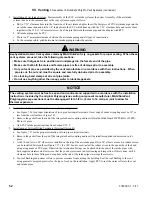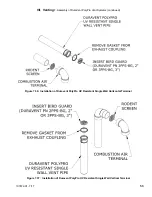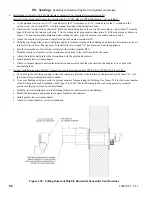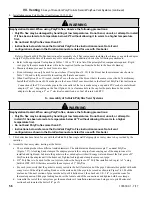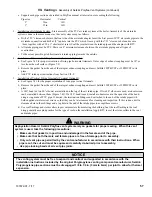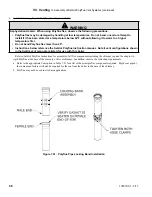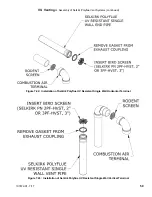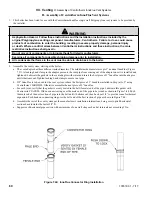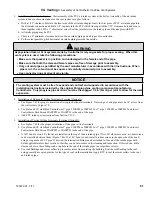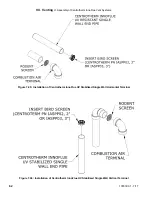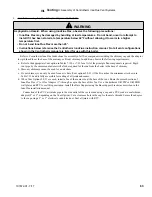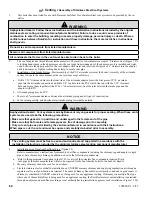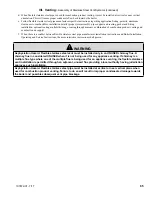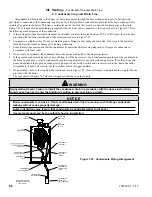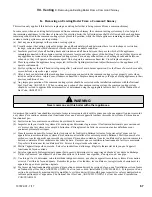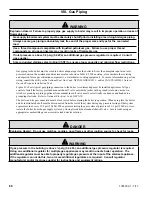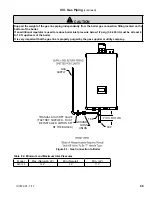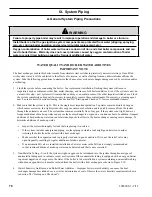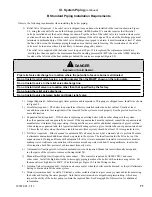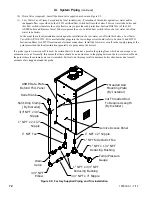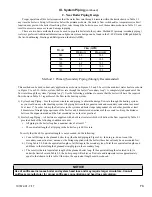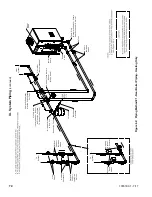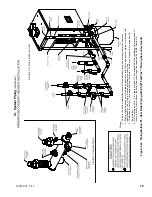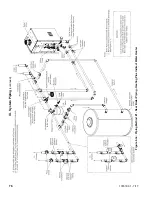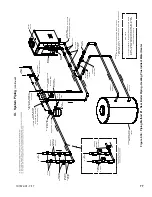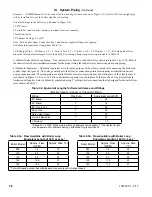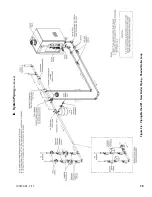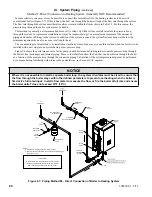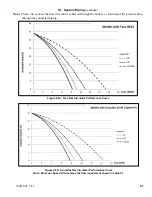
66
107672-01 - 7/17
Figure 7.47: Condensate Piping Arrangement
VII. Venting
J. Condensate Trap and Drain Line
Warning
Asphyxiation Hazard. Failure to install the condensate drain in accordance with the above instructions
could cause flue gas to enter the building, resulting in personal injury or death.
nOTiCE
Boiler condensate is corrosive. Route condensate drain line in a manner such that any condensate
leakage will not cause property damage.
Some jurisdictions may require that condensate be neutralized prior to disposal.
Use materials approved by the authority having jurisdiction.
J. Condensate Trap and Drain Line
All condensate which forms in the boiler or vent system passes through the heat exchanger and out of a bottom drain
port which is connected to the condensate trap with a hose. This trap allows condensate to drain from the heat exchanger while
retaining flue gases in the boiler. This trap is an integral part of the boiler but must be connected to a drain pipe as shown in
Figure 7.47
.
A length of corrugated tubing is supplied with the boiler and is connected to the trap as shown in Figure 747. Note
the following when disposing of the condensate:
1. If the corrugated condensate drain line must be extended, construct the extension from PVC or CPVC pipe.
Insert the hose
provided with the boiler into the end of the extension as shown in Figure 7.47.
2. Condensate is slightly acidic. Do not use metallic pipe or fittings in the condensate drain line. Do not route the drain line
through areas that could be damaged by leaking condensate.
3. Some jurisdictions may require that the condensate be neutralized before being disposed of. Dispose of condensate in
accordance with local codes.
4. Do not route, or terminate, the condensate drain line in areas subjected to freezing temperatures.
5. If the point of condensate disposal is above the trap, it will be necessary to use a condensate pump to move the condensate to
the drain. In such cases, select a condensate pump that is appropriate for use with condensing boilers. If overflow from this
pump would result in property damage, select a pump with an overflow switch and use this switch to shut down the boiler.
Alternatively, if heat is a necessity, use the overflow switch to trigger an alarm.
6. Do not attempt to move the trap from the location shown in Figure 7.47. Do not attempt to substitute another trap for the one
provided with the boiler.
7. The vent shown in Figure 7.47 must be left open for the trap to work properly.
INTAKE AIR
ADAPTER
VENT
ADAPTER
SUMP
PRESSURE
SWITCH
HEAT
EXCHANGER
CONDENSATE
TRAP VENT
HOSE FROM HEAT
EXCHANGER
SUMP PRESSURE
SWITCH TUBING
CONDENSATE
TRAP VENT
TUBING
CONDENSATE
TRAP
CONDENSATE
TRAP CLEANOUT
CORRUGATED
CONDENSATE
TUBING FROM
TRAP
CONDENSATE
DRAIN PIPE
(NOT SUPPLIED)
TUBING CLAMP
(NOT SUPPLIED)
SOME COMPONENTS
IN CABINET OMITTED
FOR CLARITY
Summary of Contents for K2WT-080B
Page 83: ...83 107672 01 7 17 PAGE LEFT INTENTIONALLY BLANK...
Page 89: ...89 107672 01 7 17 X Wiring continued Figure 10 5 Internal Ladder Diagram...
Page 90: ...90 107672 01 7 17 X Wiring continued...
Page 91: ...91 107672 01 7 17 Figure 10 6 Internal Wiring Connections Diagram X Wiring continued...
Page 102: ...102 107672 01 7 17 Lighting and Operating Instructions XI Start Up and Checkout continued...
Page 147: ...147 107672 01 7 17 XV Service Parts continued...
Page 151: ...151 107672 01 7 17 XV Service Parts continued...
Page 153: ...153 107672 01 7 17 XV Service Parts continued 85 86 91 95...
Page 162: ...162 107672 01 7 17...
Page 163: ...163 107672 01 7 17...
Page 164: ...164 107672 01 7 17...
Page 165: ...165 107672 01 7 17...
Page 166: ...166 107672 01 7 17...
Page 167: ...167 107672 01 7 17...

